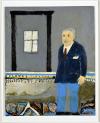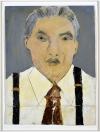Dmytro Stryjek: Found in Translation
24 September 2016 – 19 March 2017
Dmytro Stryjek: Found in Translation
Дмитро Стриєк: Знайдений в Перекладі
24 September 2016 – 19 March 2017
24 Вересня 2016 – 19 Березня 2017
Organized by the MacKenzie Art Gallery with the support of Canada Council for the Arts, SaskCulture, Saskatchewan Arts Board, and University of Regina, marking the 125th Anniversary of Ukrainian Immigration to Canada (1891-2016).
Організовано Мистецькою галереєю Маккензі в честь 125-ої Річниці Еміграції Українців в Канаду (1891-2016), за підтримки Канадської Ради Мистецтва, СаскКультури, Мистецької Ради Саскачевану, Mерії Mіста Реджайна і Університету Реджайни.
_______________________________________________________________________
To mark the 125th Anniversary of Ukrainian Immigration to Canada (1891–2016), the MacKenzie Art Gallery is pleased to present an exhibition that reveals new insights into the visual and linguistic world of Saskatchewan artist Dmytro Stryjek (1899–1991). Born and raised in western Ukraine before moving to Canada in the 1920s, Stryjek lived between two cultures and two languages. Stryjek’s subject matter is filled with veneration for Old World sources (Ukrainian poets, icons, churches) while at the same time looking toward New World subjects (pop stars, politicians, prairie scenery). This intersection is further reflected in the inscriptions which appear on the reverse side of many of his paintings. Written in both English and Ukrainian using a mix of Latin and Cyrillic scripts, they are evidence of a bicultural state of mind.
To assist in deciphering these inscriptions, the MacKenzie engaged Ukrainian translator, Iryna Boryshkevych, herself a recent immigrant to Canada. Her invaluable insights have resulted in corrections to many titles and new information about the subject matter contained among the over 380 works held in the MacKenzie’s permanent collection. Among the discoveries was a signature line which appears on almost every painting: змалювава Дмитро Страєк (zmalûvava Dmytro Stryjek). While the verb змальовувати has the basic meaning “to paint or to draw,” it is best translated in this context as “to copy.” Indeed, with few exceptions, Stryjek’s paintings are copies of existing images which he found in books, postcards, album covers, posters and magazines. In those few instances where the artist composed a subject from his imagination, this inscription does not appear.
Like the icon painters whose work he knew from Ukrainian Catholic and Orthodox churches, Stryjek did not see copying in a negative light, but as an integral part of his artistic practice. Unlike icon painters, however, Stryjek’s work embraces the world outside the church with an infectious curiosity and sense of wonder. Through the work of translation, Stryjek’s gifts as an interpreter of two worlds are newly brought into focus, pointing to the importance of his contribution as one of Canada’s finest Ukrainian-Canadian artists.
Biography
Dmytro Stryjek was born 5 November 1899 in the village of Lanivtsi in what is now western Ukraine. The son of a small land-owner, he received limited schooling and little exposure to art. At eighteen, he was conscripted by the Austro-Hungarian Army, but later joined the Ukrainian nationalist forces before the conclusion of World War One. In 1920 he married Annie Wasylenko, whose father had left Ukraine to homestead in Vonda, Saskatchewan. Stryjek soon followed suit, leaving for Canada in 1923, but he soon abandoned farming to work for the Canadian National Railway. He eventually settled in Hafford, Saskatchewan, where he attended the Ukrainian Catholic Church and took up painting on his own sometime in the late 1950s. After retirement, Stryjek moved to Saskatoon and began painting in earnest. Using bright enamel paints, including nail polish, he developed a distinctive vision that is rooted in “place as iconographic memory and place as dreamscape,” as described by poet Patrick Lane. First appearing in the Mendel Art Gallery exhibition Saskatchewan Primitives in 1975, his work has been featured in several exhibitions of Saskatchewan self-taught artists. In 1988, a major retrospective, Dmytro Stryjek: Trying the Colours, was organized by the Thunder Bay Art Gallery and toured to the MacKenzie Art Gallery. Over the years, he received major encouragement from Peter Millard, a Saskatoon professor, scholar, and collector who championed Stryjek’s work until the artist’s death in 1991. In 1999, the MacKenzie Art Gallery acquired 378 works by purchase and donation from Millard’s personal collection, making the MacKenzie home to the single largest repository of Stryjek’s work.
Dmytro Stryjek, Self-portrait, 1984, mixed media on card, 30.9 x 25.2 cm. Collection of the MacKenzie Art Gallery, gift of Peter Millard. Photo: Don Hall
Dmytro Stryjek, Self-portrait, 1980, oil, graphite, varnish on card, 30.4 x 23.1 cm. Collection of the MacKenzie Art Gallery. Photo: Don Hall
Events
-
![]()
Special Programming
Shary Boyle: Outside the Palace of Me Spotlight Tour with Sylvia Ziemann
20 April 2024
-
![]()
Studio Sunday
Puppet Workshop with Sylvia Ziemann
21 April 2024
-
![Three figures march through the winter snow carrying a transparent canoe shaped structure that glows from the inside.]()
Studio Sunday
It’s 2050: Sci-fi comics
28 April 2024





